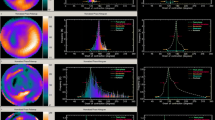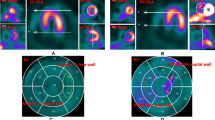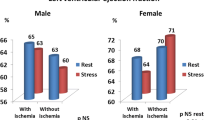Abstract
Background
The aim of this study was to establish different degrees of mechanical dyssynchrony according to validated cut-off (CO) values of myocardial perfusion gated SPECT phase analysis parameters (SD, standard deviation; B, bandwidth; S, skewness; K, kurtosis).
Methods
Using Emory Cardiac Toolbox™, we prospectively analyzed 408 patients (mean age 64.1 years, 26.7% female), divided into a control group of 150 normal subjects and a validation group of 258 patients (left bundle branch block: 17.8%, right bundle branch block: 8.9%. atrial fibrillation: 16.3%, coronary revascularization: 30%, dilated cardiomyopathy: 7.4%. valvulopathies: 2.7%, ischemic test: 45.3%) with ischemic and non-ischemic cardiac diseases, by means of phase analysis.
Results
Agreement of CO values (SD > 18.4°; B > 51°; S ≤ 3.2; K ≤ 9.3) used to discriminate between normal subjects and patients was strong (c-statistic 0.9; 95% CI 0.98-0.99). Four degrees of dyssynchrony were found according to the number of abnormal phase parameters. All patients with mechanical and electrical criteria for cardiac resynchronization therapy (CCRT) (n: 82) had Grade 2 to 4 (two to four abnormal phase parameters). Agreement of CO values (SD > 40.2°; B > 132°; S ≤ 2.3; K ≤ 4.6) used to discriminate between patients with and without CCRT was strong (c-statistic 0.8; 95% CI 0.79-0.87) but 12% of patients with CCRT did not have any of these abnormal phase parameters.
Conclusions
The discriminatory capacity of gated SPECT phase analysis parameters between normal subjects and patients, and between patients with and without CCRT, is very good, making it possible to define different degrees of mechanical dyssynchrony.






Similar content being viewed by others
Abbreviations
- B :
-
Bandwidth
- CO:
-
Cut-off
- CCRT:
-
Criteria for cardiac resynchronization therapy
- EF:
-
Ejection fraction
- K :
-
Kurtosis
- LV:
-
Left ventricle
- ROC:
-
Receiver operating characteristic
- S :
-
Skewness
- SD:
-
Standard deviation
References
Trimble MA, Borges-Neto S, Honeycutt EF, Shaw LK, Pagnanelli R, Chen J, et al. Evaluation of mechanical dyssynchrony and myocardial perfusion using phase analysis of gated SPECT imaging in patients with left ventricular dysfunction. J Nucl Cardiol. 2000;15:663–70.
Chen J, Garcia EV, Folks RD, Cooke CD, Faber TL, Tauxe EL, et al. Onset of left ventricular mechanical contraction as determined by phase analysis of ECG-gated myocardial perfusion SPECT imaging: Development of a diagnostic tool for assessment of cardiac mechanical dyssynchrony. J Nucl Cardiol. 2005;12:687–95.
Trimble MA, Borges-Neto S, Smallheiser S, Chen J, Honeycutt EF, Shaw LK, et al. Evaluation of left ventricular mechanical dyssynchrony as determined by phase analysis of ECG-gated SPECT myocardial perfusion imaging in patients with left ventricular dysfunction and conduction disturbances. J Nucl Cardiol. 2007;14:298–307.
Trimble MA, Borges-Neto S, Honeycutt EF, Smallheiser S, Chen J, Shaw LK, et al. Evaluation of mechanical dyssynchrony and myocardial perfusion using phase analysis of gated SPECT imaging in patients with left ventricular dysfunction. J Nucl Cardiol. 2008;15:663–70.
Boogers MM, Chen J, Bax JJ. Myocardial perfusion single photon emission computed tomography for the assessment of mechanical dyssynchrony. Curr Opin Cardiol. 2008;23:431–9.
Atchley AE, Trimble MA, Samad Z, Shaw LK, Pagnanelli R, Chen J, et al. Use of phase analysis of gated SPECT perfusion imaging to quantify dyssynchrony in patients with mild-to-moderate left ventricular dysfunction. J Nucl Cardiol. 2009;16:888–94.
Samad Z, Atchley AE, Trimble MA, Sun JL, Shaw LK, Pagnanelli R, et al. Prevalence and predictors of mechanical dyssynchrony as defined by phase analysis in patients with left ventricular dysfunction undergoing gated SPECT myocardial perfusion imaging. J Nucl Cardiol. 2011;18:24–30.
Henneman MM, Chen J, Ypenburg C, Dibbets P, Bleeker GB, Boersma E, et al. Phase analysis of gated myocardial perfusion single-photon emission computed tomography compared with tissue Doppler imaging for the assessment of left ventricular dyssynchrony. J Am Coll Cardiol. 2007;49:1708–14.
Marsan NA, Henneman MM, Chen J, Ypenburg C, Dibbets P, Ghio S, et al. Left ventricular dyssynchrony assessed by two threedimensional imaging modalities: Phase analysis of gated myocardial perfusion SPECT and tri-plane tissue Doppler imaging. Eur J Nucl Med Mol Imaging. 2008;35:166–73.
Van Kriekinge SD, Nishina H, Ohba M, Berman DS, Germano G. Automatic global and regional phase analysis from gated myocardial perfusion SPECT imaging: application to the characterization of ventricular contraction in patients with left bundle branch block. J Nucl Med. 2008;49:1790–7.
Murrow J, Esteves F, Galt J, Chen J, Garcia E, Lin J, et al. Characterization of mechanical dyssynchrony measured by gated single photon emission computed tomography phase analysis after acute ST-elevation myocardial infarction. J Nucl Cardiol. 2011;18:912–9.
Aljaroudi WA, Hage FG, Hermann D, Doppalapudi H, Venkataraman R, Heo J, et al. Relation of left-ventricular dyssynchrony by phase analysis of gated SPECT images and cardiovascular events in patients with implantable cardiac defibrillators. J Nucl Cardiol. 2010;17:398–404.
Chen J, Henneman MM, Trimble MA, Bax JJ, Borges-Neto S, Iskandrian AE, et al. Assessment of left ventricular mechanical dyssynchrony by phase analysis of ECG-gated SPECT myocardial perfusion imaging. J Nucl Cardiol. 2008;15:127–36.
Chen J, Faber TL, Cooke CD, Garcia EV. Temporal resolution of multiharmonic phase analysis of ECG-gated myocardial perfusion SPECT studies. J Nucl Cardiol. 2008;15:383–91.
Li D, Zhou Y, Feng J, Yuan D, Cao K, Garcia EV, et al. Impact of image reconstruction on phase analysis of ECG-gated myocardial perfusion SPECT studies. Nucl Med Commun. 2009;30:700–5.
Chen CC, Huang WS, Hung GU, Chen WC, Kao CH, Chen J. Left-ventricular dyssynchrony evaluated by Tl-201 gated SPECT myocardial perfusion imaging: A comparison with Tc-99m sestamibi. Nucl Med Commun. 2013;34:229–32.
Trimble MA, Velazquez EJ, Adams GL, Honeycutt EF, Pagnanelli RA, Barnhart HX, Chen J, et al. Repeatability and reproducibility of phase analysis of gated single-photon emission computed tomography myocardial perfusion imaging used to quantify cardiac dyssynchrony. Nucl Med Commun. 2008;29:374–81.
Henneman MM, Chen J, Dibbets-Schneider P, Stokkel MP, Bleeker GB, Ypenburg C, et al. Can LV dyssynchrony as assessed with phase analysis on gated myocardial perfusion SPECT predict response to CRT? J Nucl Med. 2007;48:1104–11.
Pazhenkottil AP, Buechel RR, Husmann L, Nkoulou RN, Wolfrum M, Ghadri JR, et al. Long-term prognostic value of left ventricular dyssynchrony assessment by phase analysis from myocardial perfusion imaging. Heart. 2011;97:33–7.
Chen J, Kalogeropoulos AP, Verdes L, Butler J, Garcia EV. Left-ventricular systolic and diastolic dyssynchrony as assessed by multi-harmonic phase analysis of gated SPECT myocardial perfusion imaging in patients with end-stage renal disease and normal LVEF. J Nucl Cardiol. 2011;18:299–308.
Romero-Farina G, Aguadé-Bruix S, Candell-Riera J, Pizzi MN, García-Dorado D. Cut-off values of myocardial perfusion gated-SPECT phase analysis parameters of normal subjects, and conduction and mechanical cardiac diseases. J Nucl Cardiol. 2015;22:1247–58.
Dickstein K, Vardas PE, Auricchio A, Daubert JC, Linde C, McMurray J, ESC Committee for Practice Guidelines (CPG), et al. Focused Update of ESC Guidelines on device therapy in heart failure: an update of the 2008 ESC Guidelines for the diagnosis and treatment of acute and chronic heart failure and the 2007 ESC guidelines for cardiac and resynchronization therapy. Eur Heart J. 2010;2010(31):2677–87.
Landis JR, Koch GG. The measurement of observer agreement for categorical data. Biometrics. 1977;33:159–74.
Hosmer DW, Lemeshow S. Applied logistic regression. New York, NY: Wiley; 1989.
Hosmer DW, Lemeshow S. Applied logistic regression. 2nd ed. New York, NY: Wiley; 2000.
Lin X, Xu H, Zhao X, Folks RD, Garcia EV, Soman P, et al. Repeatability of left ventricular dyssynchrony and function parameters in serial gated myocardial perfusion SPECT studies. J Nucl Cardiol. 2010;17:811–6.
Zafrir N, Nevzorov R, Bental T, Strasberg B, Gutstein A, Mats I, et al. Prognostic value of left ventricular dyssynchrony by myocardial perfusion-gated SPECT in patients with normal and abnormal left ventricular functions. J Nucl Cardiol. 2014;21:532–40.
Hess PL, Shaw LK, Fudim M, Iskandrian AE, Borges-Neto S. The prognostic value of mechanical left ventricular dyssynchrony defined by phase analysis from gated single-photon emission computed tomography myocardial perfusion imaging among patients with coronary heart disease. J Nucl Cardiol 2016 Jan 25 [Epub ahead of print]
Disclosure
The authors declare that they have no financial conflicts of interest.
Author information
Authors and Affiliations
Corresponding author
Additional information
See related editorial, doi: 10.1007/s12350-016-0717-7.
The authors of this article have provided a PowerPoint file, available for download at SpringerLink, which summarizes the contents of the paper and is free for re-use at meetings and presentations. Search for the article DOI on SpringerLink.com.
Electronic supplementary material
Below is the link to the electronic supplementary material.
Rights and permissions
About this article
Cite this article
Aguadé-Bruix, S., Romero-Farina, G., Candell-Riera, J. et al. Mechanical dyssynchrony according to validated cut-off values using gated SPECT myocardial perfusion imaging. J. Nucl. Cardiol. 25, 999–1008 (2018). https://doi.org/10.1007/s12350-016-0684-z
Received:
Accepted:
Published:
Issue Date:
DOI: https://doi.org/10.1007/s12350-016-0684-z




